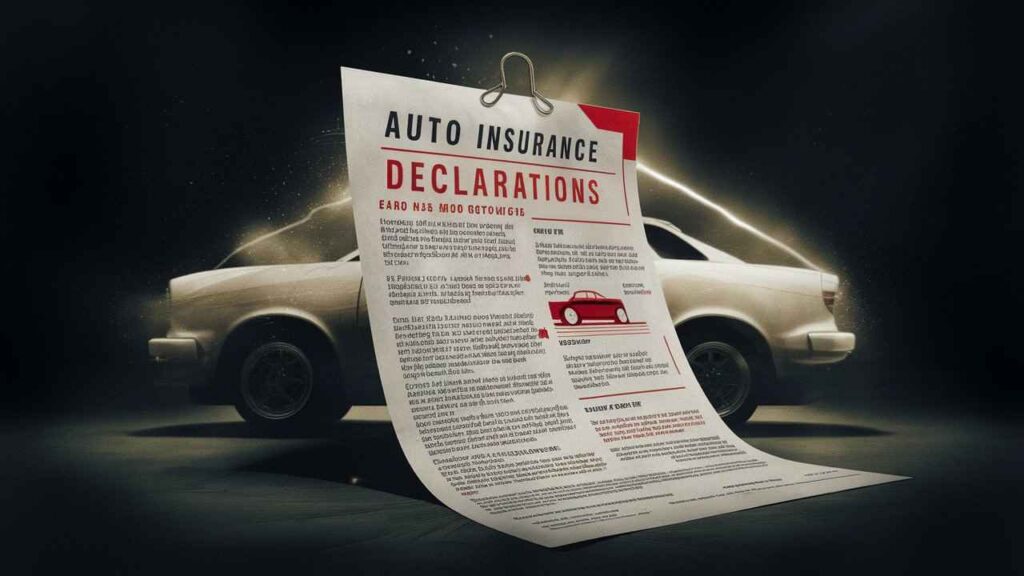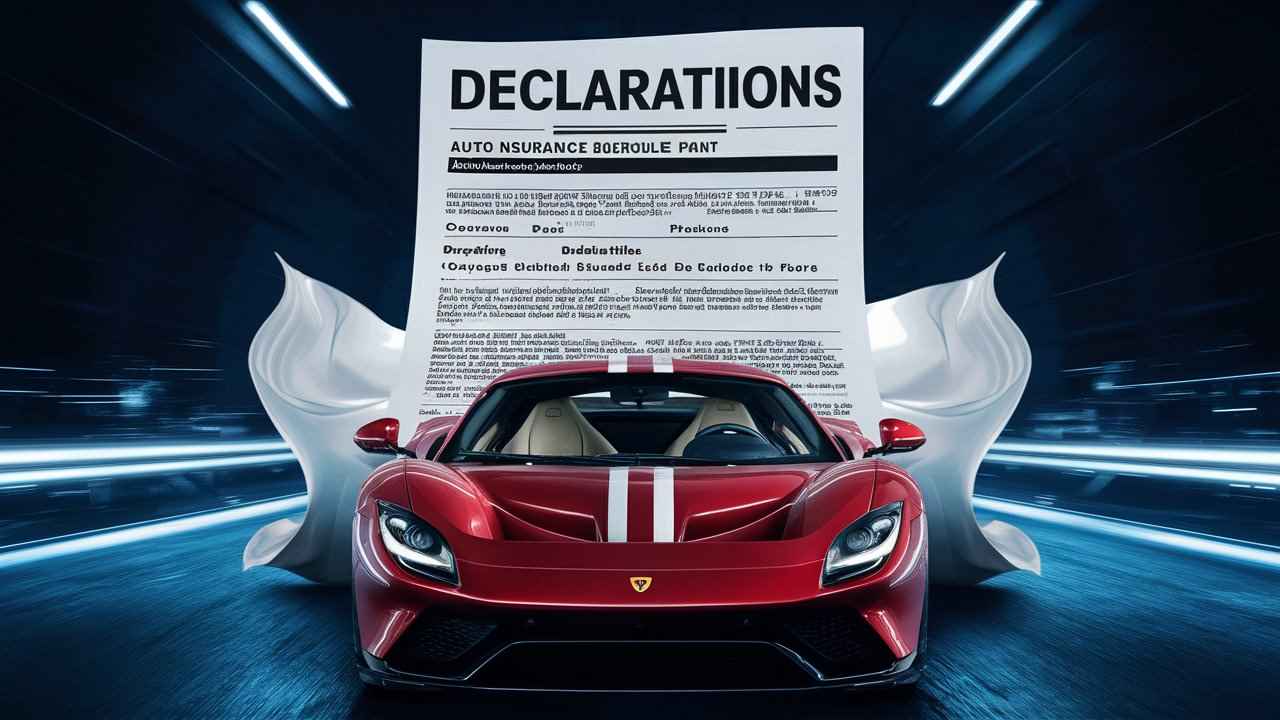Why the Declarations Page is the Key to Your Auto Insurance Policy
Imagine your auto insurance policy is a puzzle💵complex, detailed, and maybe a bit overwhelming. Now, the declarations page? That’s the cheat sheet! It’s the one-stop guide to everything your insurance covers, distilled into a few tidy sections. If you ignore it, you’re driving blind (pun fully intended). It’s the foundation upon which every claim and decision about your coverage will rest. Let’s break down why this unsung hero deserves your attention.

Decoding Insurance Jargon: A Quick Overview
The declarations page is filled with words that sound like they were plucked from an insurance textbook written by a robot. “Bodily injury liability,” “uninsured motorist,” “comprehensive deductible” 💵yeah, it’s not exactly bedtime reading. But understanding these terms is critical. Consider this your Rosetta Stone for auto insurance jargon. Let’s translate these terms into something we can all understand and use.
What is an Auto Insurance Declarations Page?
Breaking It Down: What Exactly is the Declarations Page?
At its core, the auto insurance declarations page is a summary. It’s like the CliffsNotes of your policy, giving you the key points without making you wade through pages of fine print. It outlines the essentials: what’s covered, how much you’re paying, and for how long. But it’s more than just a summary💵it’s your insurance roadmap.
How the Declarations Page Differs from the Rest of Your Policy
Unlike the full policy, which reads like a never-ending legal document, the declarations page cuts straight to the point. It’s your go-to for quick reference. Need to check your coverage limits? It’s there. Want to know when your policy expires? Look no further. It’s the quick-access version of your policy, while the rest of your insurance paperwork is the “terms and conditions” nobody actually reads.💵

Key Components of the Declarations Page
Personal Information: Why Your Name and Address Matter
That’s right💵your personal info is more than just fluff. Your name and address tie your policy to you and your vehicle, and any error here could lead to issues when it’s time to file a claim. Make sure it’s accurate because even a small mistake could complicate things in a big way.
Vehicle Details: What the Insurers Need to Know About Your Car
Your car’s make, model, year, and VIN (Vehicle Identification Number) all appear here. This is the section that connects the insurance coverage to the right vehicle. If you’re insuring a 2019 Ford Mustang but it lists your old 2002 Honda Civic, that’s a problem. Be vigilant here.
Policy Number and Effective Dates: Don’t Overlook These!
These details tell you when your coverage begins and ends, and your policy number is like your policy’s fingerprint. Knowing your effective dates ensures you’re not driving uninsured between renewal periods, and keeping your policy number handy simplifies any future claim processes.💵

Types of Coverage Listed on the Declarations Page
Liability Coverage: What You’re Legally Required to Have
Liability coverage is the safety net required by law in most states. It protects you financially if you’re responsible for causing injury or damage in an accident. Without it, you could face massive out-of-pocket costs and even legal penalties.
Comprehensive vs. Collision: What’s the Difference?
Comprehensive coverage protects your car from non-collision-related damage💵think natural disasters, theft, or a runaway shopping cart. Collision coverage? It’s for when you and another vehicle (or object) don’t get along. Both serve different purposes, and knowing how they work is crucial to understanding what you’re paying for.
Medical Payments Coverage: Is It Really Necessary?
Medical Payments Coverage (MedPay) helps pay medical expenses for you and your passengers, regardless of who’s at fault in an accident. It’s not required in every state, but if you don’t have health insurance or high deductibles, it could be a lifesaver.
Uninsured/Underinsured Motorist Coverage: Protection from the Unknown
This coverage comes into play when the person who hits you doesn’t have enough (or any) insurance. It’s a layer of financial protection that ensures you’re not left paying for someone else’s mistake.💵

Limits of Liability: The Numbers You Can’t Afford to Ignore
What Do Those Numbers Mean? 50/100/25 Explained
Ever see 50/100/25 on your policy and wonder what it means? It’s shorthand for your coverage limits. The first number is the per-person bodily injury limit, the second is the per-accident limit, and the third covers property damage. Understanding these numbers could make or break your financial health in a major accident.
How to Choose the Right Coverage Limits for You
The minimum coverage required by law may not be enough to fully protect you. Choosing the right limits means balancing what you can afford with what could happen in a worst-case scenario. Going cheap now could cost you later.💵

Premium Breakdown: Where Does Your Money Really Go?
What Affects Your Premium? More Than You Think
Your premium isn’t just a random number. It’s determined by factors like your driving history, credit score, where you live, and even your vehicle’s safety features. The math behind it might surprise you.
Why Your Deductible Matters (and How to Choose the Right One)
Your deductible is the amount you pay out-of-pocket before your insurance kicks in. Higher deductibles lower your premium, but they also mean more money upfront if you file a claim. It’s a balancing act worth mastering.💵
Discounts and Surcharges on Your Declarations Page
Hidden Discounts You Might Be Missing
From bundling your home and auto insurance to safe driver discounts, there are savings to be found if you know where to look. Check your declarations page for discounts you could be overlooking.
Surcharges: Why Your Rates Might Go Up Without You Knowing
Speeding ticket? Minor accident? Your insurer might have quietly added a surcharge to your premium. Spotting these sneaky charges on your declarations page can help you budget better and negotiate lower rates.💵

Additional Insureds: Who Else is Covered?
Family Members and Other Drivers: Are They Included?
If other people drive your car, you’ll want to know whether they’re covered under your policy. This section reveals who’s included in your coverage and who’s on their own.
Lending Your Car: Who’s Covered in Case of an Accident?
When you let someone borrow your car, your insurance usually follows the vehicle. But there are exceptions! This is where the details get murky, so make sure you’re informed before tossing someone else your keys.
Endorsements and Riders: Special Add-Ons You Should Know About
Gap Insurance: Is It Worth the Extra Cost?
If your car is totaled and you owe more on it than it’s worth, gap insurance steps in to pay the difference. Is the peace of mind worth the extra fee? That depends on your financial situation and your car loan.💵
Roadside Assistance: Do You Really Need It?
Roadside assistance is like carrying a safety net in your trunk. While it’s great to have, you might already be covered through your credit card or auto club. Double-check before paying for this add-on.
Understanding Exclusions on Your Declarations Page
What’s NOT Covered by Your Auto Insurance Policy
Exclusions spell out exactly what your insurance won’t cover, and this section is critical. It’s where you’ll find the fine print about events, circumstances, or drivers not covered under your policy.💵
Common Exclusions That Can Surprise You
Things like intentional damage, certain natural disasters, or using your car for business might not be covered. Understanding these exclusions can prevent unpleasant surprises down the road.
How to Read the Fine Print on Your Declarations Page
The Devil’s in the Details: What Most People Miss
Small details can have big consequences, especially in insurance. Overlooking a line or two in the fine print can lead to denied claims or inadequate coverage when you need it most.💵
Red Flags to Watch Out For in the Fine Print
Sometimes, the fine print hides potential deal-breakers💵like clauses that can void your coverage or raise your premium unexpectedly. Being able to spot these red flags can save you a headache later.
How Often Should You Review Your Declarations Page?
Why an Annual Review Could Save You Money
Your insurance needs change over time. Reviewing your declarations page annually ensures your coverage still fits your life. You might find that you’re paying for coverage you no longer need or missing out on discounts.💵
Life Changes That Should Prompt a Policy Update
Big life events like moving, buying a new car, or adding a teen driver to your policy should trigger an immediate review of your declarations page. These changes can drastically alter your coverage needs.
What to Do If You Spot Errors on Your Declarations Page
Common Mistakes and How to Fix Them
Errors happen, and when they do, they can cost you. Mistakes like incorrect vehicle information or misspelled names need to be corrected immediately. Learn how to spot these issues and address them with your insurer.💵
The Process of Correcting Errors with Your Insurer
Fixing errors isn’t always as easy as making a quick phone call. It’s important to know the proper steps, from gathering documentation to confirming the changes with your insurer.
How the Declarations Page Impacts Your Claims Process
Filing a Claim: Where the Declarations Page Comes Into Play
When you file a claim, the declarations page is one of the first things your insurer will review. It determines the limits of your coverage and how much of the claim they’ll cover.
How Your Coverage Limits Affect Your Claim Payout
Your coverage limits directly influence the amount your insurance will pay out in the event of a claim. If your limits are too low, you could be on the hook for the remaining costs. Choose wisely!
What Happens When You Renew or Change Your Policy
Understanding the Changes in Your Declarations Page During Renewal
Renewals often come with changes💵higher premiums, adjusted coverage limits, or new discounts. Keep an eye on your declarations page to see what’s different with each renewal.
Adding or Removing Coverage: How It Affects Your Page
Modifying your coverage, whether it’s adding a new driver or removing comprehensive coverage on an old car, will alter your declarations page. Make sure it accurately reflects these updates.
Comparing Declarations Pages from Different Insurers
Why Not All Policies are Created Equal
Not all auto insurance policies are cut from the same cloth. Comparing declarations pages from different insurers can reveal significant differences in coverage, limits, and costs.💵
What to Look for When Switching Insurance Providers
When you’re shopping around, the declarations page is your best friend. It helps you compare apples to apples by outlining exactly what each policy offers and at what price.
Digital vs. Paper: How to Access Your Declarations Page
Paper Statements vs. Online Accounts: Which is Better?
Some people prefer having a hard copy, while others love the convenience of digital. But is one better than the other? Let’s dive into the pros and cons of each method for accessing your declarations page.💵
How to Keep Your Declarations Page Safe and Accessible
Whether it’s digital or paper, keeping your declarations page in a secure yet accessible place is key. After all, you don’t want to be searching for it in the middle of filing a claim.
How Your Declarations Page Affects Your Legal Standing
The Legal Weight of Your Declarations Page in Disputes
If you ever end up in a legal dispute over your coverage, your declarations page can serve as critical evidence. It’s the official record of your coverage, limits, and policy details.💵
How the Declarations Page Protects You in Case of an Accident
In the event of an accident, your declarations page proves what coverage you have, ensuring you’re not left exposed to financial liability beyond your means.
Case Studies: Real-World Examples of How the Declarations Page Matters
When a Simple Mistake Cost Big: A Real Story
One missed detail on a declarations page led to a denied claim, and the driver was left paying out-of-pocket. Learn from this cautionary tale and check your declarations page carefully.
How One Change on the Declarations Page Saved a Fortune
By updating their coverage limits, one driver avoided financial ruin after a serious accident. It’s a powerful reminder of why regularly reviewing your declarations page is crucial.💵
Frequently Asked Questions
Commonly Asked Questions About the Declarations Page Answered
From “What is a deductible?” to “Can I change my coverage limits mid-policy?”, we’ll answer the most common questions drivers have about their declarations pages.
Misconceptions People Have About Their Auto Insurance Declarations
Think your declarations page lists everything? Think again. We’ll debunk some of the biggest myths about what the declarations page does and doesn’t cover.💵
Conclusion
The Importance of Knowing What’s on Your Declarations Page
Your declarations page isn’t just paperwork💵it’s your lifeline in understanding your auto insurance. Ignoring it could cost you, so make sure to review and understand it.
Next Steps: Review, Update, and Save
Now that you know what to look for, take the time to review your declarations page. Update it if necessary and rest easy knowing you’re fully covered.
Call to Action
Ready to Take Control? Review Your Declarations Page Now
Don’t wait for an accident or claim to review your coverage. Take charge today by reading through your declarations page and ensuring you’re protected.💵
Need Help? Contact an Insurance Expert to Review Your Policy
If all this still sounds like Greek to you, don’t hesitate to reach out to an expert. A professional can help you navigate the complexities and optimize your coverage.
People Also Ask
Where is the Declarations page of an insurance policy?
The Declarations page is typically located at the beginning of your insurance policy document. It serves as the summary, providing an overview of the essential details about your coverage, such as policyholder information, coverage limits, and effective dates.
How to read a declaration page?
To read a declaration page effectively, start at the top, where you’ll find the policyholder’s name and address. Next, check the policy number and effective dates. After that, look for the coverage details, including types and limits of coverage, deductibles, and any additional insured parties. Lastly, pay attention to discounts and any exclusions mentioned.
What is in the declarations section of an insurance policy?
The declarations section of an insurance policy includes key details such as the policyholder’s name and contact information, policy number, coverage limits, effective dates, and any applicable endorsements or riders. It acts as a summary of your insurance coverage.
How do I find my declaration page on the Allstate app?
To find your declaration page on the Allstate app, log in to your account, navigate to the “Policies” section, and select the relevant auto insurance policy. There, you should see an option to view or download your declaration page.
What is an auto declaration?
An auto declaration is a document that summarizes the details of your auto insurance policy, including coverage types, limits, deductibles, and the vehicles covered. It serves as a quick reference for understanding your auto insurance coverage.
What is a declaration of policy?
A declaration of policy is a document that outlines the terms, conditions, and coverage of an insurance policy. It specifies what is covered, what is excluded, and the obligations of both the insurer and the insured.
Is an insurance declaration page the same as a binder?
No, an insurance declaration page is not the same as a binder. The declaration page provides a summary of coverage, while a binder is a temporary insurance document that provides proof of coverage until the official policy is issued.
Are exclusions on the Declarations page?
Exclusions are not typically detailed on the Declarations page but may be referenced. They are usually found in the policy itself, outlining what is not covered under your insurance plan.
What is a copy of the declaration page?
A copy of the declaration page is a printed or digital version of your insurance summary. It includes essential information about your coverage and serves as proof of your insurance policy.
Why is the declaration page important?
The declaration page is important because it provides critical information about your insurance coverage. It allows you to verify your coverage limits, understand your responsibilities, and ensure that all details are accurate before filing a claim.
What is a declaration page in a report?
In the context of a report, a declaration page is a statement affirming the authenticity and accuracy of the information contained within the report. It may also outline the purpose and scope of the report.
What is the declarations page of the insurance policy?
The declarations page of an insurance policy is a summary document that outlines key information, including the insured’s details, policy limits, coverage types, and effective dates. It serves as a quick reference for understanding the policy.
How to write a declaration?
To write a declaration, start by clearly stating the purpose of the declaration. Include your name, date, and any relevant details about the subject matter. Be concise and straightforward, ensuring that the declaration accurately reflects your intentions.
How do you fill out a declaration statement?
To fill out a declaration statement, provide your personal information, such as your name and contact details, and state the purpose of the declaration. Be sure to include any necessary dates, signatures, and additional details pertinent to the declaration.
What is the common policy declarations page?
The common policy declarations page is a standard document included in most insurance policies. It provides a summary of the policyholder’s information, coverage details, and limits, allowing for easy reference and understanding of the policy.
How to read an insurance policy?
To read an insurance policy, begin with the declarations page for an overview. Next, read through the coverage sections to understand what is included and excluded. Pay attention to definitions, conditions, and claims procedures to grasp your rights and responsibilities fully.
What is the declaration section?
The declaration section is a part of an insurance policy that provides key information about the policyholder, coverage types, limits, and effective dates. It serves as a summary, helping policyholders understand their insurance coverage at a glance.
What is an insurance document?
An insurance document is any official paperwork related to an insurance policy. This includes the policy itself, declarations pages, endorsements, and any communications from the insurer, serving as a record of coverage and obligations.









